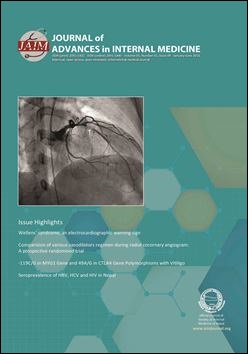Seroprevalence of hepatitis B virus, hepatitis C virus and human immunodeficiency virus in the western region of Nepal
DOI:
https://doi.org/10.3126/jaim.v5i1.17064Keywords:
Seroprevalence, HBV, HCV, HIV, alcoholic liver diseaseAbstract
Background and aims: The hepatitis B virus (HBV), hepatitis C virus (HCV) and human immunodeficiency virus (HIV) are associated with major public health concerns. The aim of the study was to determine the seroprevalence of HBV, HCV and HIV in the western region of Nepal.
Methods: This was a cross-sectional observational study, in which 15,791 patients, attending to Manipal Teaching Hospital, Pokhara, Nepal, were investigated for HBV, HCV and HIV from June 2013 to March 2016; demographic and biochemical profile were studied among the patients with positive test results.
Results: Among 15,791 patients [male 6614 (41.9%) and female 9177 (58.1%)], HBV was found in 180 (1.1%), HCV in 52 (0.3%) and HIV in 77 (0.5%). The HBV was found in 63.9% of males and 36.1% of females, HCV in 67.3% of males and 32.7% of females, and HIV in 61% of males and 39% of females which showed that males had more positivity of HBV (P<0.001), HCV (P<0.001) and HIV (P 0.001) than that of female. The HBV was found more in 20-29 years age group (27.2%), HCV in 30-39 years (32.7%), and HIV in 40-49 years (28.6%), with all having p<0.001. Among the patients of HBV, HCV and HIV, the mean values of total bilirubin were 1.4 mg/dl, 0.8 mg/dl and 2.6 mg/dl, Aspartate Transaminase 75.9 U/L, 54.3 U/L and 92.7 U/L, Alanine Transaminase 54.6 U/L, 55.5 U/L and 56.1 U/L, and Alkaline Phosphatase 124.2 U/L, 109.2 U/L and 107.2 U/L, respectively. The majority of patients with HCV had a history of intravenous drug abuse and HIV had concomitant alcoholic liver disease.
Conclusion: The HBV was more prevalent followed by HIV and HCV in the western region of Nepal with more prevalence seen in males than in females. Regular screening of HBV, HCV and HIV among the selected patients can help detecting many new cases in Nepal.
Journal of Advances in Internal Medicine 2016;05(01):6-10
Downloads
Downloads
Published
How to Cite
Issue
Section
License
This license enables reusers to distribute, remix, adapt, and build upon the material in any medium or format, so long as attribution is given to the creator.




